|
*************************************************************************************************************
By Margaret Auld-Louie
Did you know that even some premium pet food
brands may have misleading marketing claims? When looking for the best food for your pet,
it helps to know a little bit about how meats are labeled and what the
terms really mean. Recently a customer complained to us that the chicken
in Life’s Abundance canned cat food, which we offer, is raised in cages
and not as high quality as some premium
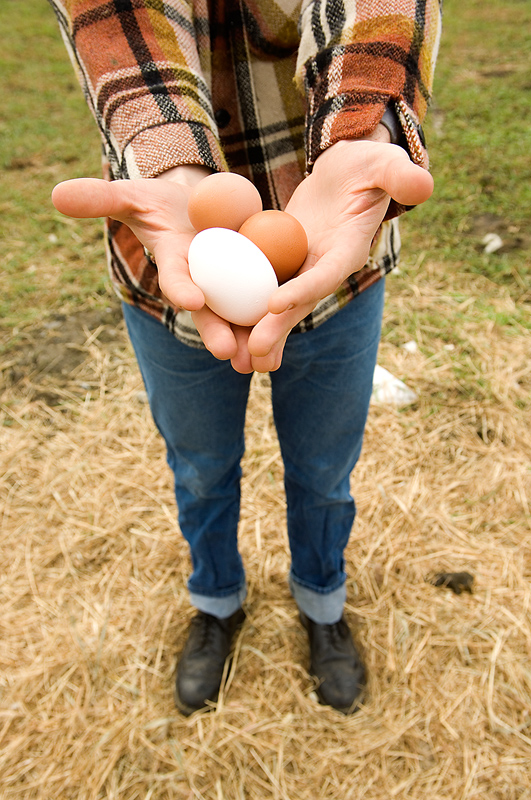 brands found in stores (which is
not true, as we will explain). Actually, no meat chickens anywhere are
raised in cages. Only egg-laying chickens are raised in cages. However,
companies may use the term “cage-free” on their meat chickens for
marketing purposes, though it doesn’t indicate any difference in how
their chickens are raised vs. other chickens. One premium pet food
company boasts that their poultry is 98% cage free, though this means
nothing and is just a marketing ploy. Also, you should be aware that ALL
chicken in the USA that is not labeled as either “organic” or “No GMOs”
is fed GMO feed, because almost all corn and soy raised in the USA is
now genetically modified (GMO). This matters because
GMOs most likely
have adverse health effects, which you can learn more by reading
our March, 2010, e-newsletter article
Are Genetically Modified Organisms (GMO) Bad? or at :
www.responsibletechnology.org/. brands found in stores (which is
not true, as we will explain). Actually, no meat chickens anywhere are
raised in cages. Only egg-laying chickens are raised in cages. However,
companies may use the term “cage-free” on their meat chickens for
marketing purposes, though it doesn’t indicate any difference in how
their chickens are raised vs. other chickens. One premium pet food
company boasts that their poultry is 98% cage free, though this means
nothing and is just a marketing ploy. Also, you should be aware that ALL
chicken in the USA that is not labeled as either “organic” or “No GMOs”
is fed GMO feed, because almost all corn and soy raised in the USA is
now genetically modified (GMO). This matters because
GMOs most likely
have adverse health effects, which you can learn more by reading
our March, 2010, e-newsletter article
Are Genetically Modified Organisms (GMO) Bad? or at :
www.responsibletechnology.org/.
There are a lot of terms misused for marketing
purposes when it comes to selling chickens. Did you know that
“free-range” chickens are not raised outdoors? Almost all chickens
raised for meat are raised indoors in barns, sometimes as many as 20,000
to a facility. Even organic chickens are densely packed into indoor
barns. Unfortunately, what are labeled as “free-range” chickens only
require a door to the outside, which typically is a tiny door leading to
a concrete slab. There are no requirements for how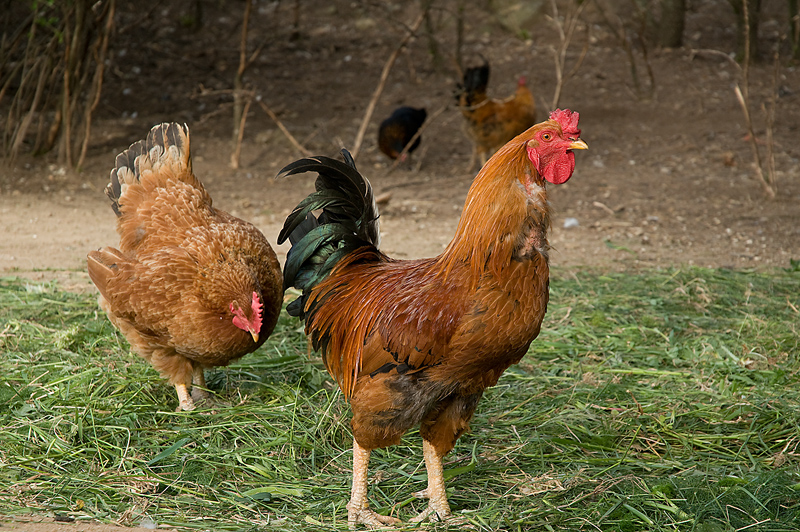 long chickens need to
be outdoors so they typically spend most, if not all, of their time
indoors in crowded conditions. long chickens need to
be outdoors so they typically spend most, if not all, of their time
indoors in crowded conditions.
To get chickens that are raised outdoors, you
must purchase what are called "pastured" or "pasture-raised" chickens.
They might be raised in a dirt pen rather than a grassy pasture, but
they will be raised outdoors. These are typically only available
directly from farmers, as they are not mass-produced for stores. Those
“natural” and “organic” chickens you see in health food stores are not
pastured chickens, unless you see them specifically labeled as
“pastured”. While you can now find eggs in stores from pastured
chickens, we have not yet found any pastured meat chickens in stores.
In some parts of the country, such as Colorado
(where we live), pastured chickens are very expensive
 and very difficult
to come by, because of the climate (it’s difficult to raise chickens in
a harsh climate with cold, snowy winters and hot, dry summers). As you
can imagine, with such a short supply of pastured chickens, it would not
be possible for a pet food company to find a large enough supply at a
reasonable enough price to use them in their commercial pet food
production. There must be a reasonably large supply of an ingredient for
a pet food manufacturer to be able to use it in their products. and very difficult
to come by, because of the climate (it’s difficult to raise chickens in
a harsh climate with cold, snowy winters and hot, dry summers). As you
can imagine, with such a short supply of pastured chickens, it would not
be possible for a pet food company to find a large enough supply at a
reasonable enough price to use them in their commercial pet food
production. There must be a reasonably large supply of an ingredient for
a pet food manufacturer to be able to use it in their products.
To make things even more confusing, when it
comes to beef, bison (buffalo) and lamb, the term "free-range" can actually mean
that the animals are raised and finished on pasture. To confirm this,
though, you will need to talk to the farmer or manufacturer to verify
that the animals are 100% grassfed/pasture-raised, and not just raised
initially on pasture and then finished on grain in a feedlot. Even
"organic" and "natural" beef is typically finished in feedlots and
almost all bison is grain-finished, unless labeled as 100% grassfed.
Another misleading term used to market
chickens is “hormone free” or “no hormones”. Since hormones are not
permitted in the raising of chickens, this is also a meaningless term.
To summarize, if a pet food company is using
any of the following terms to make you think their chicken is healthy,
it doesn’t mean anything and is just fancy marketing:
-
Free-range
-
Cage-free
-
No Hormones
-
Natural
-
Vegetarian
Fed—chickens are omnivores, so while this may mean that the chickens
are not eating low-quality animal byproducts, they cannot be
optimally healthy on a vegetarian diet. They eat insects, larvae and
small animals when out on pasture.
So what terms do
mean something? We suggest looking for the following in the chicken you
eat or feed your pets:
-
Organic—if you
can’t get pastured chicken, the next best thing is organic since
they will be fed organic food (which means no GMO food) and cannot
be given antibiotics starting with their first day (might be given
antibiotics in the egg.)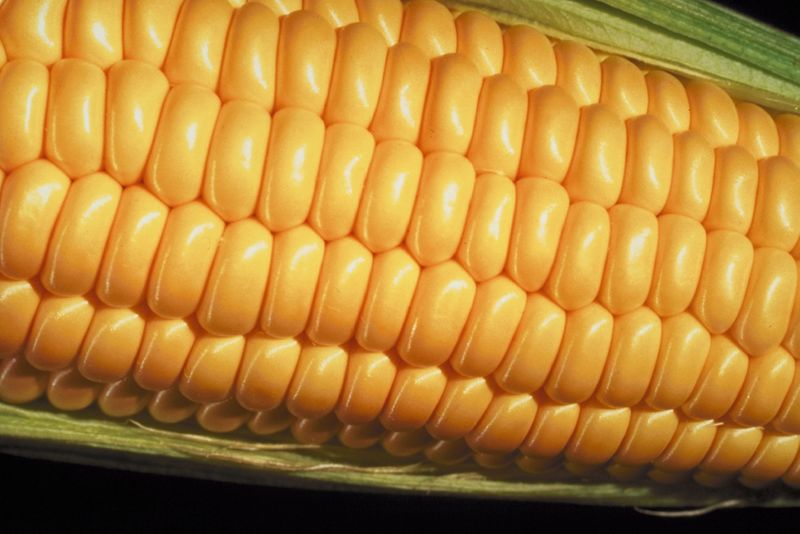
-
No GMOs—if you
can’t get organic chicken, then look for chicken marketed as “Non
GMO Project Verified”, meaning the chickens have not been fed corn,
soy or other grains containing
GMOs (genetically modified
organisms.)
-
No
Antibiotics—if you can’t get organic chicken, at least look for
antibiotic-free chickens that are raised without antibiotics
including in the egg. Chickens are fed antibiotics to make them grow
faster, but this leads to the development of antibiotic-resistant
bacteria, which are dangerous to people.
For further
explanation about what the terms on chicken labels mean, see this
article by Consumer Reports:
www.consumerreports.org/cro/magazine/2014/02/the-high-cost-of-cheap-chicken/index.htm.
Even the quality of pastured poultry can vary depending on the quality
of the supplemental feed. To learn more about chicken marketing,
including pastured chickens, see this excellent article:
www.marksdailyapple.com/what-you-should-know-about-poultry-production-claims/.
When reading pet food labels, besides looking for the best quality
chicken, what else should you look for? Look for what other ingredients
are in the food. If you are buying food for your cat, keep in mind
 that
cats are obligate carnivores, meaning they must have meat to survive.
They do not have any requirement for carbohydrates or vegetables. But
most cat foods contain those ingredients to reduce the price or give the
illusion that the food is healthy (people think vegetables are healthy
for everyone.) Pet foods often have grains added to reduce the cost,
such as wheat, barley, corn, oats, rice or millet. Or soy may be added
to foods increase the protein percentage, though dogs and cats cannot
digest it very well (and
non-organic soy is GMO.) But even if the food
is grain-free, it may be high in other starches such as peas, tapioca or
potatoes. Dr. Jean Hofve, DVM, feline nutrition expert, states that peas
are too starchy for cats and should be avoided. Look at the labels of
most grain-free canned cat foods and you will usually see one of these
alternative starches. The manufacturers add them to cut the cost of the
product. that
cats are obligate carnivores, meaning they must have meat to survive.
They do not have any requirement for carbohydrates or vegetables. But
most cat foods contain those ingredients to reduce the price or give the
illusion that the food is healthy (people think vegetables are healthy
for everyone.) Pet foods often have grains added to reduce the cost,
such as wheat, barley, corn, oats, rice or millet. Or soy may be added
to foods increase the protein percentage, though dogs and cats cannot
digest it very well (and
non-organic soy is GMO.) But even if the food
is grain-free, it may be high in other starches such as peas, tapioca or
potatoes. Dr. Jean Hofve, DVM, feline nutrition expert, states that peas
are too starchy for cats and should be avoided. Look at the labels of
most grain-free canned cat foods and you will usually see one of these
alternative starches. The manufacturers add them to cut the cost of the
product.
Many holistic vets also suggest avoiding fish for cats, which can be
found in many canned cat foods, even most premium brands. Feline
nutrition expert Dr. Jean Hofve, DVM, explains:
Why Fish is Dangerous
for Cats on her website. Fish is added to canned cat food to make it
more palatable to cats. They are probably attracted to the stinky smell
and Omega 3 oils, since wild cats eat reptiles that are high in Omega
3’s. There are healthier ways to add Omega 3 oils to your cat’s diet,
such as Moxxor. Dr. Hofve thinks so highly of the benefits of
Moxxor for
pets that she sits on their veterinary advisory board.
So, getting back to the question about the quality of
Life’s Abundance
canned cat food, why does Optimum Choices offer it? The Life’s Abundance
line of pet foods has all been formulated by Dr. Jane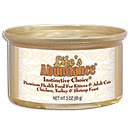 Bicks, who is a
holistic veterinarian. As such, she is aware that cats are carnivores
and thrive best on a meat-based, carbohydrate-free diet. Obviously the
Life’s Abundance cat kibble contains carbohydrates, because it’s
physically impossible to make a kibble without carbohydrates. They need
to offer a cat kibble to meet customer demand, though it is not the best
option to feed cats. But the
Life’s Abundance
canned cat food is one of
the best products on the market. Several years ago we were asked by a
local rescue organization to recommend a premium canned cat food for one
of their cats that had medical issues and needed a high quality canned
food without fish. They said they could not afford Life’s Abundance. So
we went to all the high-end pet supply stores in the area that carry the
latest in premium pet foods and read labels. We were shocked to realize
that there was nothing as good as Life’s Abundance. The vast majority of
foods had fish added. Those that did not typically had starches or
vegetables added to cut the cost. Bicks, who is a
holistic veterinarian. As such, she is aware that cats are carnivores
and thrive best on a meat-based, carbohydrate-free diet. Obviously the
Life’s Abundance cat kibble contains carbohydrates, because it’s
physically impossible to make a kibble without carbohydrates. They need
to offer a cat kibble to meet customer demand, though it is not the best
option to feed cats. But the
Life’s Abundance
canned cat food is one of
the best products on the market. Several years ago we were asked by a
local rescue organization to recommend a premium canned cat food for one
of their cats that had medical issues and needed a high quality canned
food without fish. They said they could not afford Life’s Abundance. So
we went to all the high-end pet supply stores in the area that carry the
latest in premium pet foods and read labels. We were shocked to realize
that there was nothing as good as Life’s Abundance. The vast majority of
foods had fish added. Those that did not typically had starches or
vegetables added to cut the cost.
When we look at the label for
Life’s Abundance Instinctive Choice canned
cat food, we see that it only contains organic chicken, chicken liver,
chicken broth, turkey, chicken meal, shrimp and fish oil. No
carbohydrates (starches), vegetables or fillers like cheaper brands. Some guar gum
is added to thicken the broth. Guar gum is one of the safest-possible
food additives used as a thickener. To see an analysis of its safety,
read:
chriskresser.com/harmful-or-harmless-guar-gum-locust-bean-gum-and-more?
Although Life’s
Abundance is not 100% organic, the first ingredient is organic chicken
(which means the chickens are not fed GMO-containing feed, a very
important health issue). Producing a 100% organic
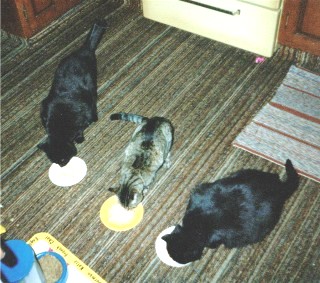 canned cat food would
likely make the product cost-prohibitive for most consumers. If you look
at the organic pet foods in stores, you will probably notice that they
have added starches and/or vegetables to reduce the cost since organic
meat is so pricey. Rather than adding fish to improve palatability,
Life’s Abundance adds shrimp, which is healthier for cats and full of
nutrients. Dr. Jean Hofve, the noted feline nutritionist and co-author
of
The Complete Guide to Holistic Cat Care, recommends and sells Life’s
Abundance cat food. We use it with our cats. We supplement their raw
diet with Life’s Abundance canned food, to reduce costs and help ensure
they receive a balanced diet. While our most finicky cat will not always
eat it, our other two cats are always happy to gobble it up. It is not
only one of the healthiest but also one of the tastiest canned cat foods
on the market. canned cat food would
likely make the product cost-prohibitive for most consumers. If you look
at the organic pet foods in stores, you will probably notice that they
have added starches and/or vegetables to reduce the cost since organic
meat is so pricey. Rather than adding fish to improve palatability,
Life’s Abundance adds shrimp, which is healthier for cats and full of
nutrients. Dr. Jean Hofve, the noted feline nutritionist and co-author
of
The Complete Guide to Holistic Cat Care, recommends and sells Life’s
Abundance cat food. We use it with our cats. We supplement their raw
diet with Life’s Abundance canned food, to reduce costs and help ensure
they receive a balanced diet. While our most finicky cat will not always
eat it, our other two cats are always happy to gobble it up. It is not
only one of the healthiest but also one of the tastiest canned cat foods
on the market.
Next time you go shopping for pet food, keep
in mind the tips in this article so you can evaluate the manufacturer's
claims and sort out the marketing hype from the facts. For even more
details on what to look for in a truly "wholistic" pet food, read our
e-Book: Save Your Dog
or Cat.
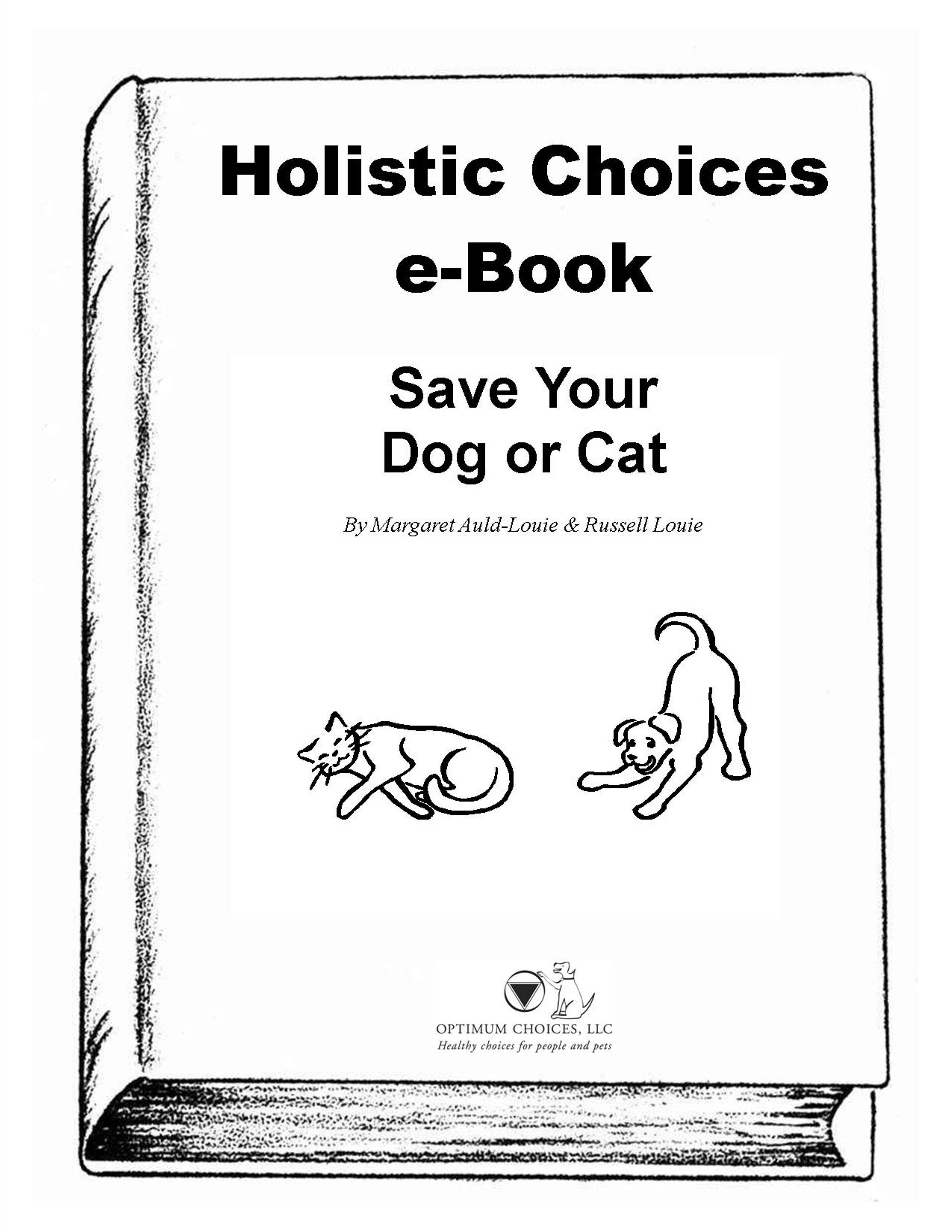
|
